Taxation Law Assignment: Residential Status and Fringe Benefits
VerifiedAdded on 2020/05/11
|13
|2961
|41
Homework Assignment
AI Summary
This taxation law assignment analyzes the residential status of an individual, Daniel, based on the domicile test, 183-day test, and superannuation test, concluding he is an Australian resident. It then computes Daniel's taxable income, including assessable income from salary, rental income, interest, and dividends, and allowable deductions, resulting in a total tax payable. The assignment further examines fringe benefit implications for Joyce, addressing salary, superannuation, school fees, travel expenses, membership costs, and car fringe benefits, referencing relevant legislation such as the ITAA 1997, ITAA 1936, and FBTAA 1986 to determine tax consequences. The analysis covers various scenarios of income and benefits, including both assessable income and deductions.
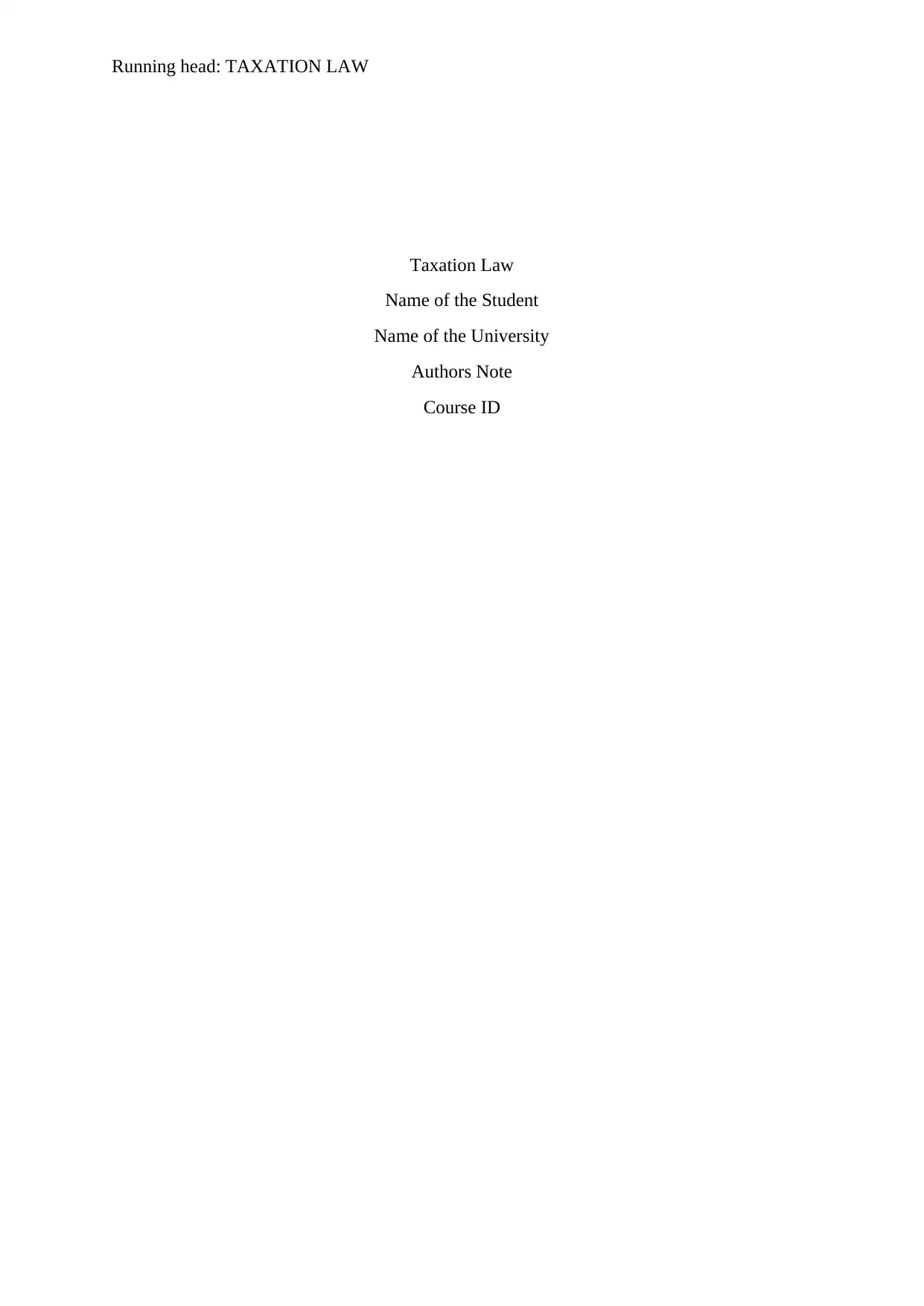
Running head: TAXATION LAW
Taxation Law
Name of the Student
Name of the University
Authors Note
Course ID
Taxation Law
Name of the Student
Name of the University
Authors Note
Course ID
Paraphrase This Document
Need a fresh take? Get an instant paraphrase of this document with our AI Paraphraser
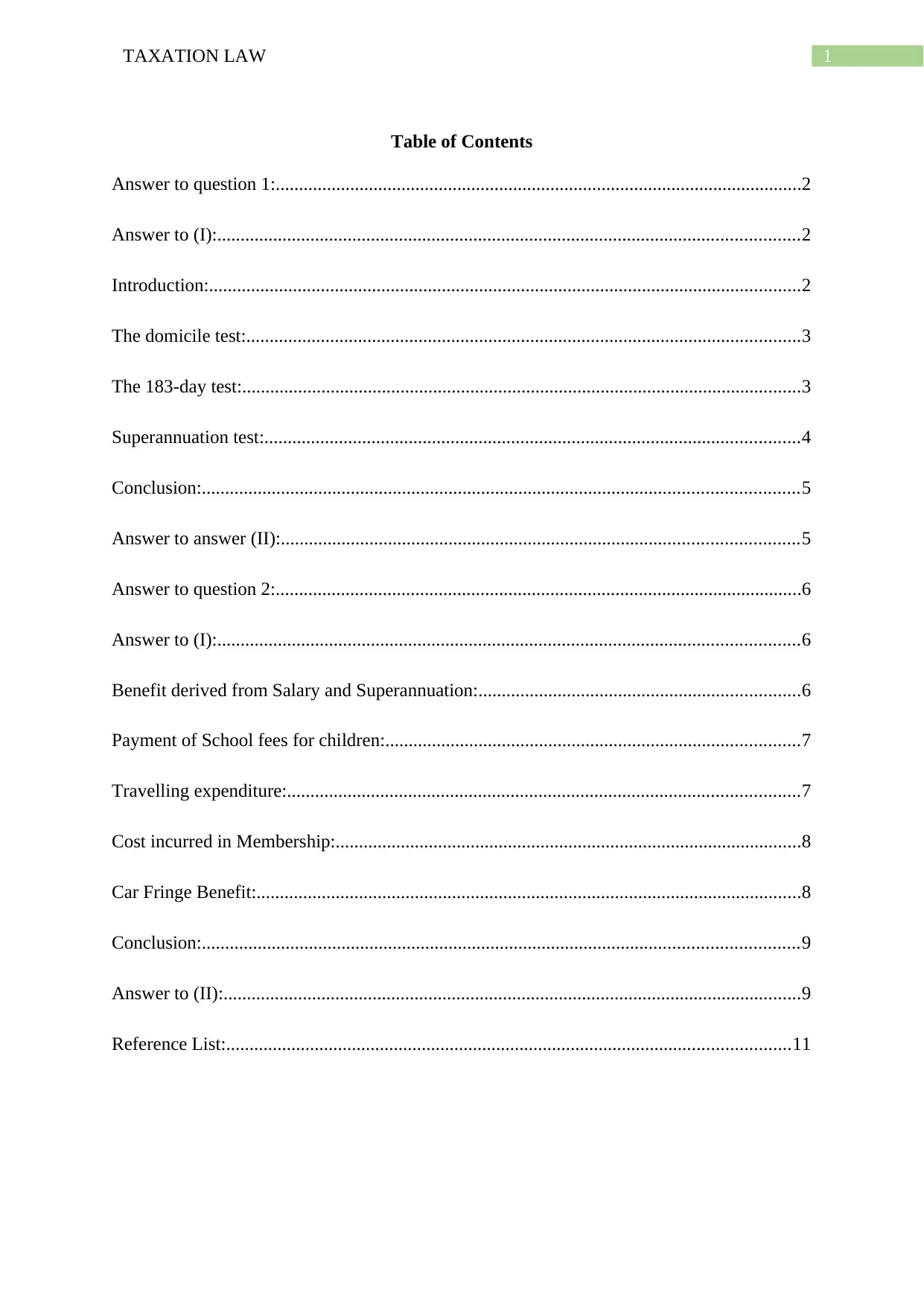
1TAXATION LAW
Table of Contents
Answer to question 1:.................................................................................................................2
Answer to (I):.............................................................................................................................2
Introduction:...............................................................................................................................2
The domicile test:.......................................................................................................................3
The 183-day test:........................................................................................................................3
Superannuation test:...................................................................................................................4
Conclusion:................................................................................................................................5
Answer to answer (II):...............................................................................................................5
Answer to question 2:.................................................................................................................6
Answer to (I):.............................................................................................................................6
Benefit derived from Salary and Superannuation:.....................................................................6
Payment of School fees for children:.........................................................................................7
Travelling expenditure:..............................................................................................................7
Cost incurred in Membership:....................................................................................................8
Car Fringe Benefit:.....................................................................................................................8
Conclusion:................................................................................................................................9
Answer to (II):............................................................................................................................9
Reference List:.........................................................................................................................11
Table of Contents
Answer to question 1:.................................................................................................................2
Answer to (I):.............................................................................................................................2
Introduction:...............................................................................................................................2
The domicile test:.......................................................................................................................3
The 183-day test:........................................................................................................................3
Superannuation test:...................................................................................................................4
Conclusion:................................................................................................................................5
Answer to answer (II):...............................................................................................................5
Answer to question 2:.................................................................................................................6
Answer to (I):.............................................................................................................................6
Benefit derived from Salary and Superannuation:.....................................................................6
Payment of School fees for children:.........................................................................................7
Travelling expenditure:..............................................................................................................7
Cost incurred in Membership:....................................................................................................8
Car Fringe Benefit:.....................................................................................................................8
Conclusion:................................................................................................................................9
Answer to (II):............................................................................................................................9
Reference List:.........................................................................................................................11
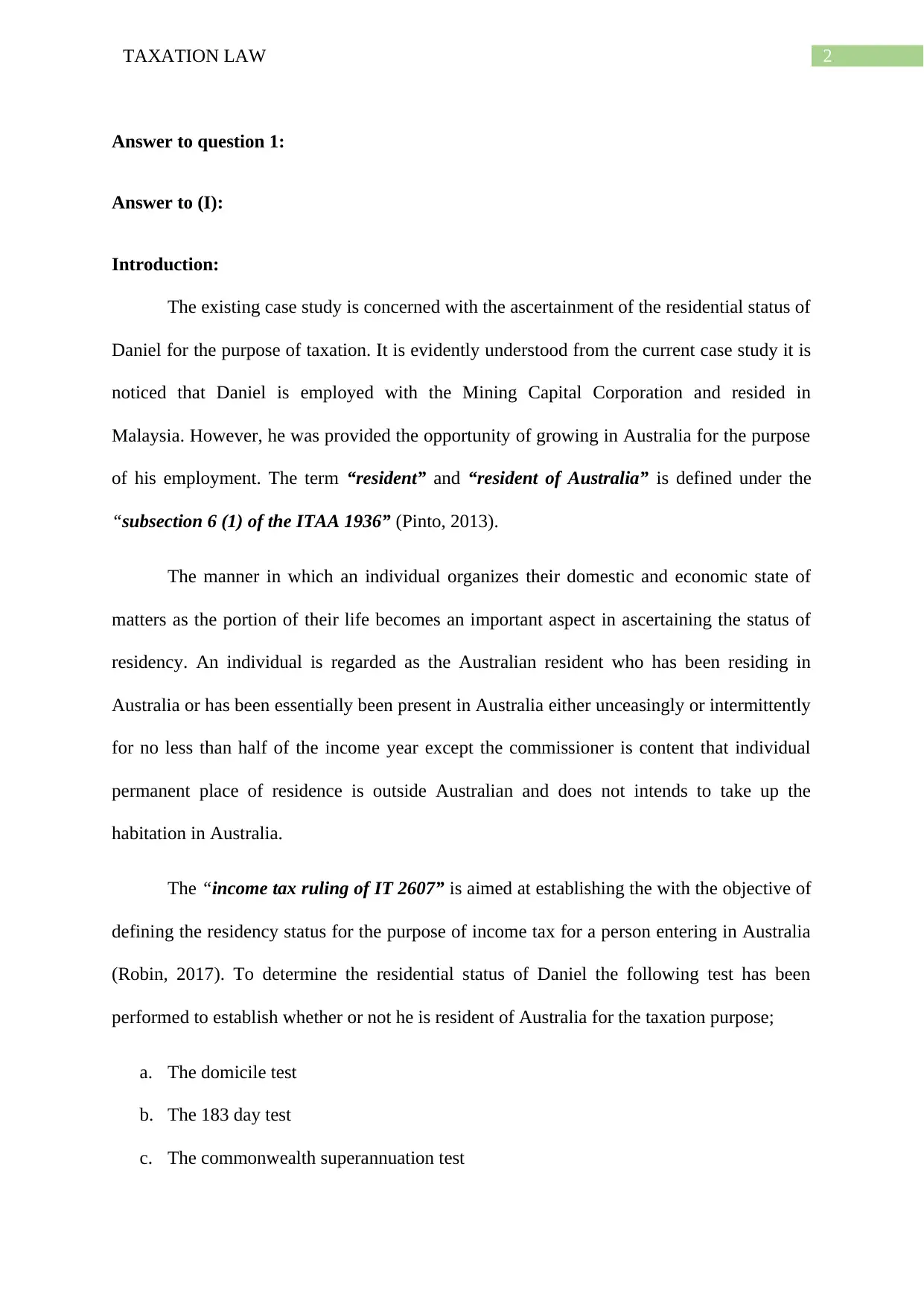
2TAXATION LAW
Answer to question 1:
Answer to (I):
Introduction:
The existing case study is concerned with the ascertainment of the residential status of
Daniel for the purpose of taxation. It is evidently understood from the current case study it is
noticed that Daniel is employed with the Mining Capital Corporation and resided in
Malaysia. However, he was provided the opportunity of growing in Australia for the purpose
of his employment. The term “resident” and “resident of Australia” is defined under the
“subsection 6 (1) of the ITAA 1936” (Pinto, 2013).
The manner in which an individual organizes their domestic and economic state of
matters as the portion of their life becomes an important aspect in ascertaining the status of
residency. An individual is regarded as the Australian resident who has been residing in
Australia or has been essentially been present in Australia either unceasingly or intermittently
for no less than half of the income year except the commissioner is content that individual
permanent place of residence is outside Australian and does not intends to take up the
habitation in Australia.
The “income tax ruling of IT 2607” is aimed at establishing the with the objective of
defining the residency status for the purpose of income tax for a person entering in Australia
(Robin, 2017). To determine the residential status of Daniel the following test has been
performed to establish whether or not he is resident of Australia for the taxation purpose;
a. The domicile test
b. The 183 day test
c. The commonwealth superannuation test
Answer to question 1:
Answer to (I):
Introduction:
The existing case study is concerned with the ascertainment of the residential status of
Daniel for the purpose of taxation. It is evidently understood from the current case study it is
noticed that Daniel is employed with the Mining Capital Corporation and resided in
Malaysia. However, he was provided the opportunity of growing in Australia for the purpose
of his employment. The term “resident” and “resident of Australia” is defined under the
“subsection 6 (1) of the ITAA 1936” (Pinto, 2013).
The manner in which an individual organizes their domestic and economic state of
matters as the portion of their life becomes an important aspect in ascertaining the status of
residency. An individual is regarded as the Australian resident who has been residing in
Australia or has been essentially been present in Australia either unceasingly or intermittently
for no less than half of the income year except the commissioner is content that individual
permanent place of residence is outside Australian and does not intends to take up the
habitation in Australia.
The “income tax ruling of IT 2607” is aimed at establishing the with the objective of
defining the residency status for the purpose of income tax for a person entering in Australia
(Robin, 2017). To determine the residential status of Daniel the following test has been
performed to establish whether or not he is resident of Australia for the taxation purpose;
a. The domicile test
b. The 183 day test
c. The commonwealth superannuation test
⊘ This is a preview!⊘
Do you want full access?
Subscribe today to unlock all pages.

Trusted by 1+ million students worldwide
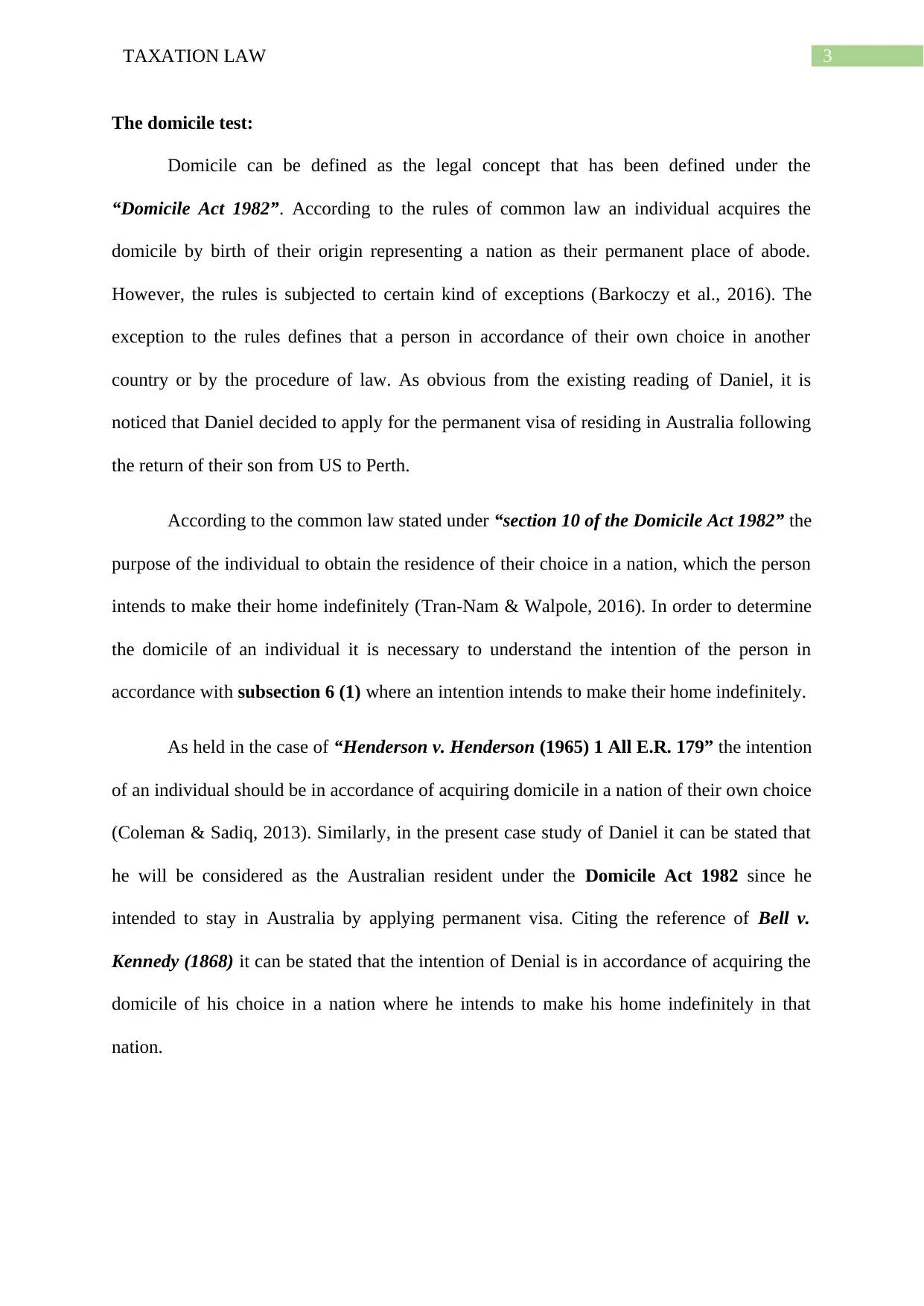
3TAXATION LAW
The domicile test:
Domicile can be defined as the legal concept that has been defined under the
“Domicile Act 1982”. According to the rules of common law an individual acquires the
domicile by birth of their origin representing a nation as their permanent place of abode.
However, the rules is subjected to certain kind of exceptions (Barkoczy et al., 2016). The
exception to the rules defines that a person in accordance of their own choice in another
country or by the procedure of law. As obvious from the existing reading of Daniel, it is
noticed that Daniel decided to apply for the permanent visa of residing in Australia following
the return of their son from US to Perth.
According to the common law stated under “section 10 of the Domicile Act 1982” the
purpose of the individual to obtain the residence of their choice in a nation, which the person
intends to make their home indefinitely (Tran-Nam & Walpole, 2016). In order to determine
the domicile of an individual it is necessary to understand the intention of the person in
accordance with subsection 6 (1) where an intention intends to make their home indefinitely.
As held in the case of “Henderson v. Henderson (1965) 1 All E.R. 179” the intention
of an individual should be in accordance of acquiring domicile in a nation of their own choice
(Coleman & Sadiq, 2013). Similarly, in the present case study of Daniel it can be stated that
he will be considered as the Australian resident under the Domicile Act 1982 since he
intended to stay in Australia by applying permanent visa. Citing the reference of Bell v.
Kennedy (1868) it can be stated that the intention of Denial is in accordance of acquiring the
domicile of his choice in a nation where he intends to make his home indefinitely in that
nation.
The domicile test:
Domicile can be defined as the legal concept that has been defined under the
“Domicile Act 1982”. According to the rules of common law an individual acquires the
domicile by birth of their origin representing a nation as their permanent place of abode.
However, the rules is subjected to certain kind of exceptions (Barkoczy et al., 2016). The
exception to the rules defines that a person in accordance of their own choice in another
country or by the procedure of law. As obvious from the existing reading of Daniel, it is
noticed that Daniel decided to apply for the permanent visa of residing in Australia following
the return of their son from US to Perth.
According to the common law stated under “section 10 of the Domicile Act 1982” the
purpose of the individual to obtain the residence of their choice in a nation, which the person
intends to make their home indefinitely (Tran-Nam & Walpole, 2016). In order to determine
the domicile of an individual it is necessary to understand the intention of the person in
accordance with subsection 6 (1) where an intention intends to make their home indefinitely.
As held in the case of “Henderson v. Henderson (1965) 1 All E.R. 179” the intention
of an individual should be in accordance of acquiring domicile in a nation of their own choice
(Coleman & Sadiq, 2013). Similarly, in the present case study of Daniel it can be stated that
he will be considered as the Australian resident under the Domicile Act 1982 since he
intended to stay in Australia by applying permanent visa. Citing the reference of Bell v.
Kennedy (1868) it can be stated that the intention of Denial is in accordance of acquiring the
domicile of his choice in a nation where he intends to make his home indefinitely in that
nation.
Paraphrase This Document
Need a fresh take? Get an instant paraphrase of this document with our AI Paraphraser
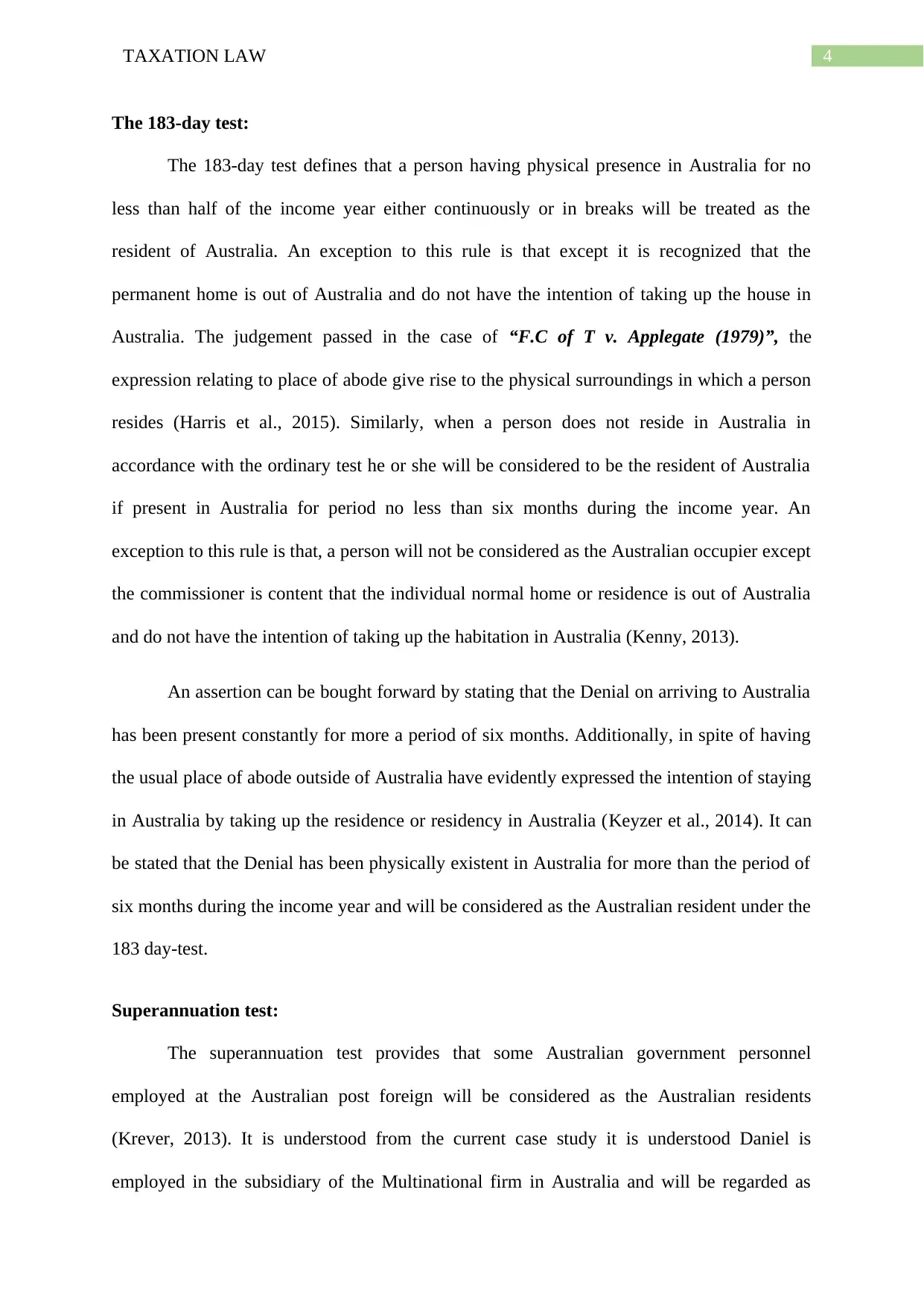
4TAXATION LAW
The 183-day test:
The 183-day test defines that a person having physical presence in Australia for no
less than half of the income year either continuously or in breaks will be treated as the
resident of Australia. An exception to this rule is that except it is recognized that the
permanent home is out of Australia and do not have the intention of taking up the house in
Australia. The judgement passed in the case of “F.C of T v. Applegate (1979)”, the
expression relating to place of abode give rise to the physical surroundings in which a person
resides (Harris et al., 2015). Similarly, when a person does not reside in Australia in
accordance with the ordinary test he or she will be considered to be the resident of Australia
if present in Australia for period no less than six months during the income year. An
exception to this rule is that, a person will not be considered as the Australian occupier except
the commissioner is content that the individual normal home or residence is out of Australia
and do not have the intention of taking up the habitation in Australia (Kenny, 2013).
An assertion can be bought forward by stating that the Denial on arriving to Australia
has been present constantly for more a period of six months. Additionally, in spite of having
the usual place of abode outside of Australia have evidently expressed the intention of staying
in Australia by taking up the residence or residency in Australia (Keyzer et al., 2014). It can
be stated that the Denial has been physically existent in Australia for more than the period of
six months during the income year and will be considered as the Australian resident under the
183 day-test.
Superannuation test:
The superannuation test provides that some Australian government personnel
employed at the Australian post foreign will be considered as the Australian residents
(Krever, 2013). It is understood from the current case study it is understood Daniel is
employed in the subsidiary of the Multinational firm in Australia and will be regarded as
The 183-day test:
The 183-day test defines that a person having physical presence in Australia for no
less than half of the income year either continuously or in breaks will be treated as the
resident of Australia. An exception to this rule is that except it is recognized that the
permanent home is out of Australia and do not have the intention of taking up the house in
Australia. The judgement passed in the case of “F.C of T v. Applegate (1979)”, the
expression relating to place of abode give rise to the physical surroundings in which a person
resides (Harris et al., 2015). Similarly, when a person does not reside in Australia in
accordance with the ordinary test he or she will be considered to be the resident of Australia
if present in Australia for period no less than six months during the income year. An
exception to this rule is that, a person will not be considered as the Australian occupier except
the commissioner is content that the individual normal home or residence is out of Australia
and do not have the intention of taking up the habitation in Australia (Kenny, 2013).
An assertion can be bought forward by stating that the Denial on arriving to Australia
has been present constantly for more a period of six months. Additionally, in spite of having
the usual place of abode outside of Australia have evidently expressed the intention of staying
in Australia by taking up the residence or residency in Australia (Keyzer et al., 2014). It can
be stated that the Denial has been physically existent in Australia for more than the period of
six months during the income year and will be considered as the Australian resident under the
183 day-test.
Superannuation test:
The superannuation test provides that some Australian government personnel
employed at the Australian post foreign will be considered as the Australian residents
(Krever, 2013). It is understood from the current case study it is understood Daniel is
employed in the subsidiary of the Multinational firm in Australia and will be regarded as
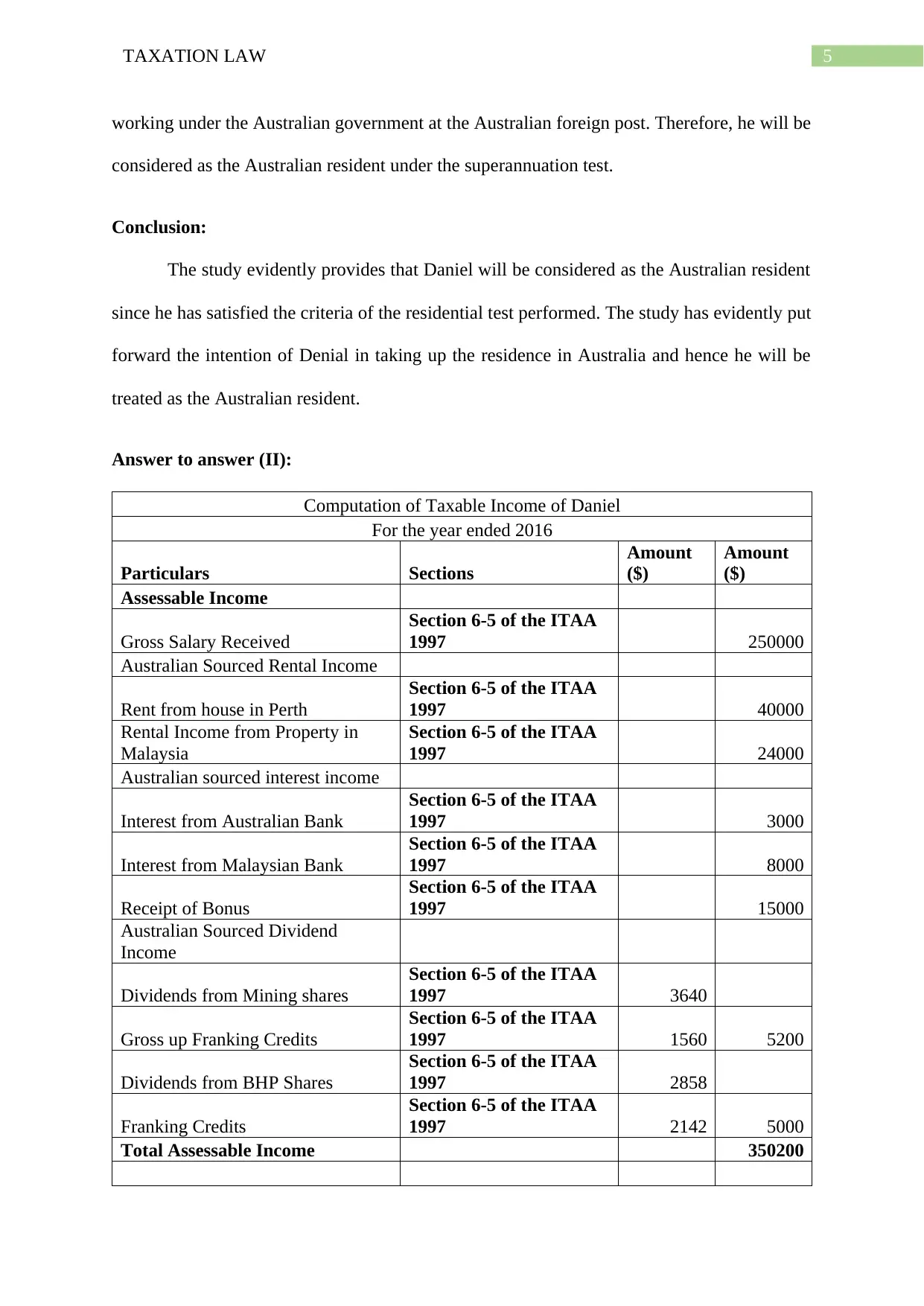
5TAXATION LAW
working under the Australian government at the Australian foreign post. Therefore, he will be
considered as the Australian resident under the superannuation test.
Conclusion:
The study evidently provides that Daniel will be considered as the Australian resident
since he has satisfied the criteria of the residential test performed. The study has evidently put
forward the intention of Denial in taking up the residence in Australia and hence he will be
treated as the Australian resident.
Answer to answer (II):
Computation of Taxable Income of Daniel
For the year ended 2016
Particulars Sections
Amount
($)
Amount
($)
Assessable Income
Gross Salary Received
Section 6-5 of the ITAA
1997 250000
Australian Sourced Rental Income
Rent from house in Perth
Section 6-5 of the ITAA
1997 40000
Rental Income from Property in
Malaysia
Section 6-5 of the ITAA
1997 24000
Australian sourced interest income
Interest from Australian Bank
Section 6-5 of the ITAA
1997 3000
Interest from Malaysian Bank
Section 6-5 of the ITAA
1997 8000
Receipt of Bonus
Section 6-5 of the ITAA
1997 15000
Australian Sourced Dividend
Income
Dividends from Mining shares
Section 6-5 of the ITAA
1997 3640
Gross up Franking Credits
Section 6-5 of the ITAA
1997 1560 5200
Dividends from BHP Shares
Section 6-5 of the ITAA
1997 2858
Franking Credits
Section 6-5 of the ITAA
1997 2142 5000
Total Assessable Income 350200
working under the Australian government at the Australian foreign post. Therefore, he will be
considered as the Australian resident under the superannuation test.
Conclusion:
The study evidently provides that Daniel will be considered as the Australian resident
since he has satisfied the criteria of the residential test performed. The study has evidently put
forward the intention of Denial in taking up the residence in Australia and hence he will be
treated as the Australian resident.
Answer to answer (II):
Computation of Taxable Income of Daniel
For the year ended 2016
Particulars Sections
Amount
($)
Amount
($)
Assessable Income
Gross Salary Received
Section 6-5 of the ITAA
1997 250000
Australian Sourced Rental Income
Rent from house in Perth
Section 6-5 of the ITAA
1997 40000
Rental Income from Property in
Malaysia
Section 6-5 of the ITAA
1997 24000
Australian sourced interest income
Interest from Australian Bank
Section 6-5 of the ITAA
1997 3000
Interest from Malaysian Bank
Section 6-5 of the ITAA
1997 8000
Receipt of Bonus
Section 6-5 of the ITAA
1997 15000
Australian Sourced Dividend
Income
Dividends from Mining shares
Section 6-5 of the ITAA
1997 3640
Gross up Franking Credits
Section 6-5 of the ITAA
1997 1560 5200
Dividends from BHP Shares
Section 6-5 of the ITAA
1997 2858
Franking Credits
Section 6-5 of the ITAA
1997 2142 5000
Total Assessable Income 350200
⊘ This is a preview!⊘
Do you want full access?
Subscribe today to unlock all pages.

Trusted by 1+ million students worldwide
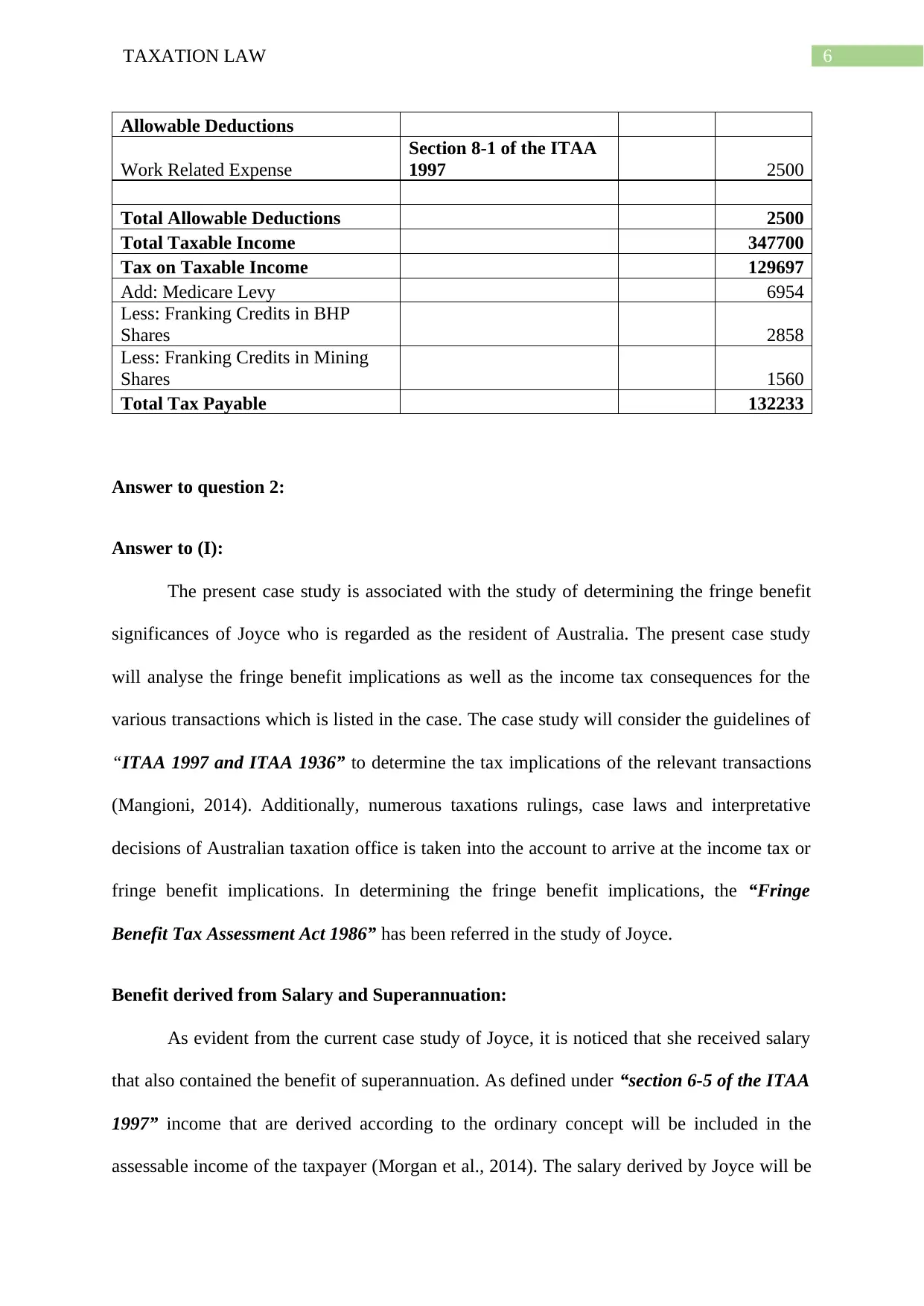
6TAXATION LAW
Allowable Deductions
Work Related Expense
Section 8-1 of the ITAA
1997 2500
Total Allowable Deductions 2500
Total Taxable Income 347700
Tax on Taxable Income 129697
Add: Medicare Levy 6954
Less: Franking Credits in BHP
Shares 2858
Less: Franking Credits in Mining
Shares 1560
Total Tax Payable 132233
Answer to question 2:
Answer to (I):
The present case study is associated with the study of determining the fringe benefit
significances of Joyce who is regarded as the resident of Australia. The present case study
will analyse the fringe benefit implications as well as the income tax consequences for the
various transactions which is listed in the case. The case study will consider the guidelines of
“ITAA 1997 and ITAA 1936” to determine the tax implications of the relevant transactions
(Mangioni, 2014). Additionally, numerous taxations rulings, case laws and interpretative
decisions of Australian taxation office is taken into the account to arrive at the income tax or
fringe benefit implications. In determining the fringe benefit implications, the “Fringe
Benefit Tax Assessment Act 1986” has been referred in the study of Joyce.
Benefit derived from Salary and Superannuation:
As evident from the current case study of Joyce, it is noticed that she received salary
that also contained the benefit of superannuation. As defined under “section 6-5 of the ITAA
1997” income that are derived according to the ordinary concept will be included in the
assessable income of the taxpayer (Morgan et al., 2014). The salary derived by Joyce will be
Allowable Deductions
Work Related Expense
Section 8-1 of the ITAA
1997 2500
Total Allowable Deductions 2500
Total Taxable Income 347700
Tax on Taxable Income 129697
Add: Medicare Levy 6954
Less: Franking Credits in BHP
Shares 2858
Less: Franking Credits in Mining
Shares 1560
Total Tax Payable 132233
Answer to question 2:
Answer to (I):
The present case study is associated with the study of determining the fringe benefit
significances of Joyce who is regarded as the resident of Australia. The present case study
will analyse the fringe benefit implications as well as the income tax consequences for the
various transactions which is listed in the case. The case study will consider the guidelines of
“ITAA 1997 and ITAA 1936” to determine the tax implications of the relevant transactions
(Mangioni, 2014). Additionally, numerous taxations rulings, case laws and interpretative
decisions of Australian taxation office is taken into the account to arrive at the income tax or
fringe benefit implications. In determining the fringe benefit implications, the “Fringe
Benefit Tax Assessment Act 1986” has been referred in the study of Joyce.
Benefit derived from Salary and Superannuation:
As evident from the current case study of Joyce, it is noticed that she received salary
that also contained the benefit of superannuation. As defined under “section 6-5 of the ITAA
1997” income that are derived according to the ordinary concept will be included in the
assessable income of the taxpayer (Morgan et al., 2014). The salary derived by Joyce will be
Paraphrase This Document
Need a fresh take? Get an instant paraphrase of this document with our AI Paraphraser
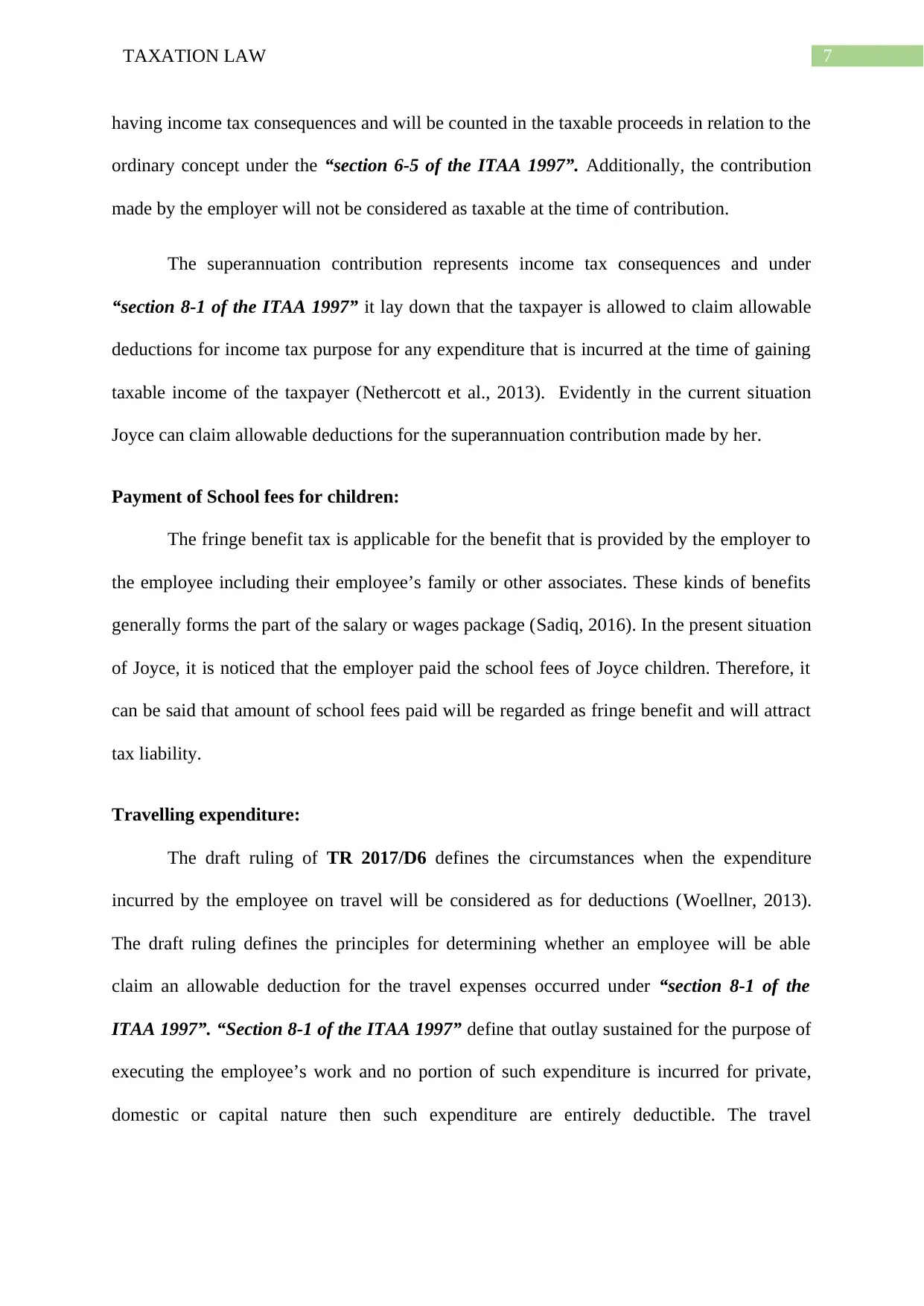
7TAXATION LAW
having income tax consequences and will be counted in the taxable proceeds in relation to the
ordinary concept under the “section 6-5 of the ITAA 1997”. Additionally, the contribution
made by the employer will not be considered as taxable at the time of contribution.
The superannuation contribution represents income tax consequences and under
“section 8-1 of the ITAA 1997” it lay down that the taxpayer is allowed to claim allowable
deductions for income tax purpose for any expenditure that is incurred at the time of gaining
taxable income of the taxpayer (Nethercott et al., 2013). Evidently in the current situation
Joyce can claim allowable deductions for the superannuation contribution made by her.
Payment of School fees for children:
The fringe benefit tax is applicable for the benefit that is provided by the employer to
the employee including their employee’s family or other associates. These kinds of benefits
generally forms the part of the salary or wages package (Sadiq, 2016). In the present situation
of Joyce, it is noticed that the employer paid the school fees of Joyce children. Therefore, it
can be said that amount of school fees paid will be regarded as fringe benefit and will attract
tax liability.
Travelling expenditure:
The draft ruling of TR 2017/D6 defines the circumstances when the expenditure
incurred by the employee on travel will be considered as for deductions (Woellner, 2013).
The draft ruling defines the principles for determining whether an employee will be able
claim an allowable deduction for the travel expenses occurred under “section 8-1 of the
ITAA 1997”. “Section 8-1 of the ITAA 1997” define that outlay sustained for the purpose of
executing the employee’s work and no portion of such expenditure is incurred for private,
domestic or capital nature then such expenditure are entirely deductible. The travel
having income tax consequences and will be counted in the taxable proceeds in relation to the
ordinary concept under the “section 6-5 of the ITAA 1997”. Additionally, the contribution
made by the employer will not be considered as taxable at the time of contribution.
The superannuation contribution represents income tax consequences and under
“section 8-1 of the ITAA 1997” it lay down that the taxpayer is allowed to claim allowable
deductions for income tax purpose for any expenditure that is incurred at the time of gaining
taxable income of the taxpayer (Nethercott et al., 2013). Evidently in the current situation
Joyce can claim allowable deductions for the superannuation contribution made by her.
Payment of School fees for children:
The fringe benefit tax is applicable for the benefit that is provided by the employer to
the employee including their employee’s family or other associates. These kinds of benefits
generally forms the part of the salary or wages package (Sadiq, 2016). In the present situation
of Joyce, it is noticed that the employer paid the school fees of Joyce children. Therefore, it
can be said that amount of school fees paid will be regarded as fringe benefit and will attract
tax liability.
Travelling expenditure:
The draft ruling of TR 2017/D6 defines the circumstances when the expenditure
incurred by the employee on travel will be considered as for deductions (Woellner, 2013).
The draft ruling defines the principles for determining whether an employee will be able
claim an allowable deduction for the travel expenses occurred under “section 8-1 of the
ITAA 1997”. “Section 8-1 of the ITAA 1997” define that outlay sustained for the purpose of
executing the employee’s work and no portion of such expenditure is incurred for private,
domestic or capital nature then such expenditure are entirely deductible. The travel
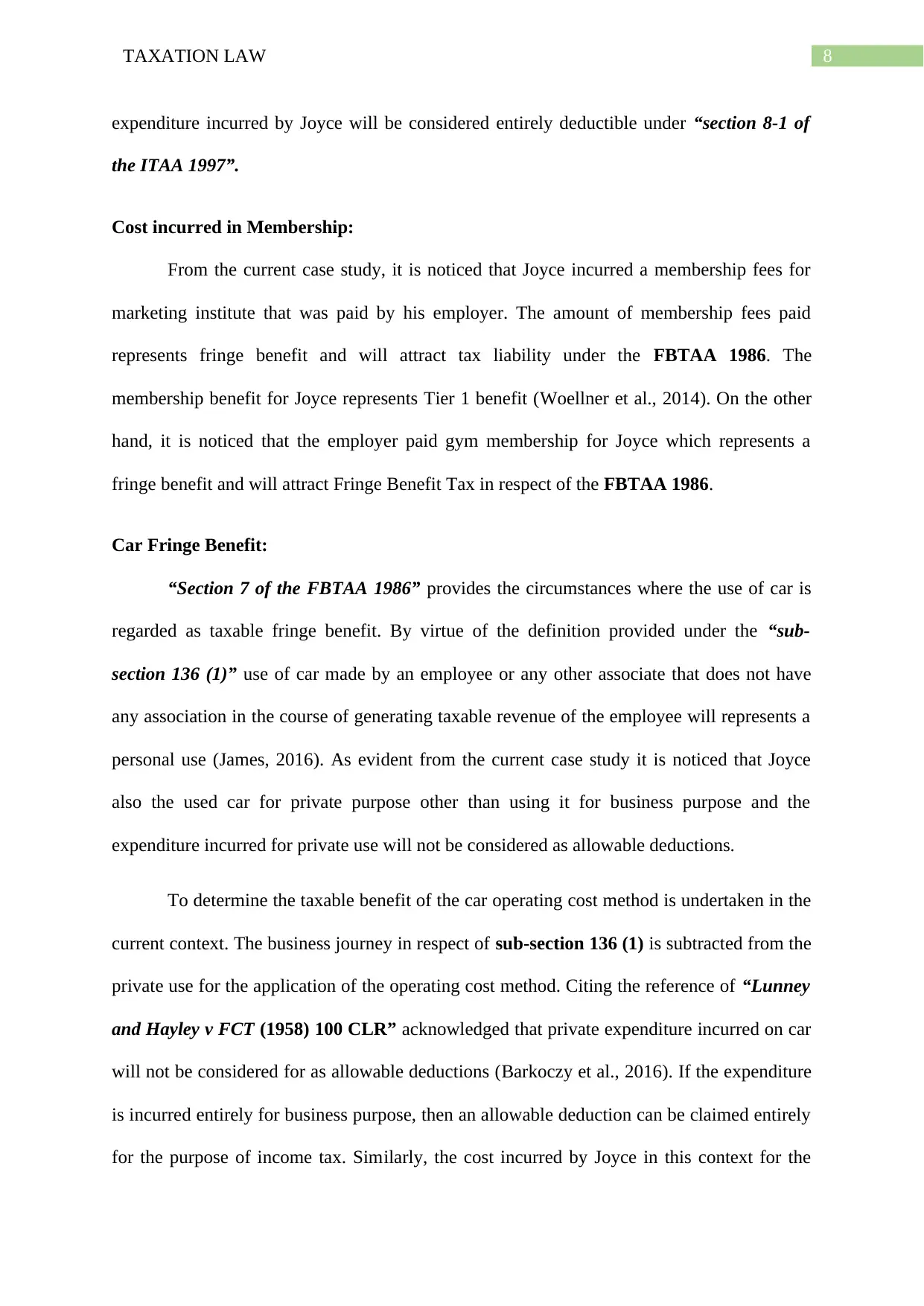
8TAXATION LAW
expenditure incurred by Joyce will be considered entirely deductible under “section 8-1 of
the ITAA 1997”.
Cost incurred in Membership:
From the current case study, it is noticed that Joyce incurred a membership fees for
marketing institute that was paid by his employer. The amount of membership fees paid
represents fringe benefit and will attract tax liability under the FBTAA 1986. The
membership benefit for Joyce represents Tier 1 benefit (Woellner et al., 2014). On the other
hand, it is noticed that the employer paid gym membership for Joyce which represents a
fringe benefit and will attract Fringe Benefit Tax in respect of the FBTAA 1986.
Car Fringe Benefit:
“Section 7 of the FBTAA 1986” provides the circumstances where the use of car is
regarded as taxable fringe benefit. By virtue of the definition provided under the “sub-
section 136 (1)” use of car made by an employee or any other associate that does not have
any association in the course of generating taxable revenue of the employee will represents a
personal use (James, 2016). As evident from the current case study it is noticed that Joyce
also the used car for private purpose other than using it for business purpose and the
expenditure incurred for private use will not be considered as allowable deductions.
To determine the taxable benefit of the car operating cost method is undertaken in the
current context. The business journey in respect of sub-section 136 (1) is subtracted from the
private use for the application of the operating cost method. Citing the reference of “Lunney
and Hayley v FCT (1958) 100 CLR” acknowledged that private expenditure incurred on car
will not be considered for as allowable deductions (Barkoczy et al., 2016). If the expenditure
is incurred entirely for business purpose, then an allowable deduction can be claimed entirely
for the purpose of income tax. Similarly, the cost incurred by Joyce in this context for the
expenditure incurred by Joyce will be considered entirely deductible under “section 8-1 of
the ITAA 1997”.
Cost incurred in Membership:
From the current case study, it is noticed that Joyce incurred a membership fees for
marketing institute that was paid by his employer. The amount of membership fees paid
represents fringe benefit and will attract tax liability under the FBTAA 1986. The
membership benefit for Joyce represents Tier 1 benefit (Woellner et al., 2014). On the other
hand, it is noticed that the employer paid gym membership for Joyce which represents a
fringe benefit and will attract Fringe Benefit Tax in respect of the FBTAA 1986.
Car Fringe Benefit:
“Section 7 of the FBTAA 1986” provides the circumstances where the use of car is
regarded as taxable fringe benefit. By virtue of the definition provided under the “sub-
section 136 (1)” use of car made by an employee or any other associate that does not have
any association in the course of generating taxable revenue of the employee will represents a
personal use (James, 2016). As evident from the current case study it is noticed that Joyce
also the used car for private purpose other than using it for business purpose and the
expenditure incurred for private use will not be considered as allowable deductions.
To determine the taxable benefit of the car operating cost method is undertaken in the
current context. The business journey in respect of sub-section 136 (1) is subtracted from the
private use for the application of the operating cost method. Citing the reference of “Lunney
and Hayley v FCT (1958) 100 CLR” acknowledged that private expenditure incurred on car
will not be considered for as allowable deductions (Barkoczy et al., 2016). If the expenditure
is incurred entirely for business purpose, then an allowable deduction can be claimed entirely
for the purpose of income tax. Similarly, the cost incurred by Joyce in this context for the
⊘ This is a preview!⊘
Do you want full access?
Subscribe today to unlock all pages.

Trusted by 1+ million students worldwide
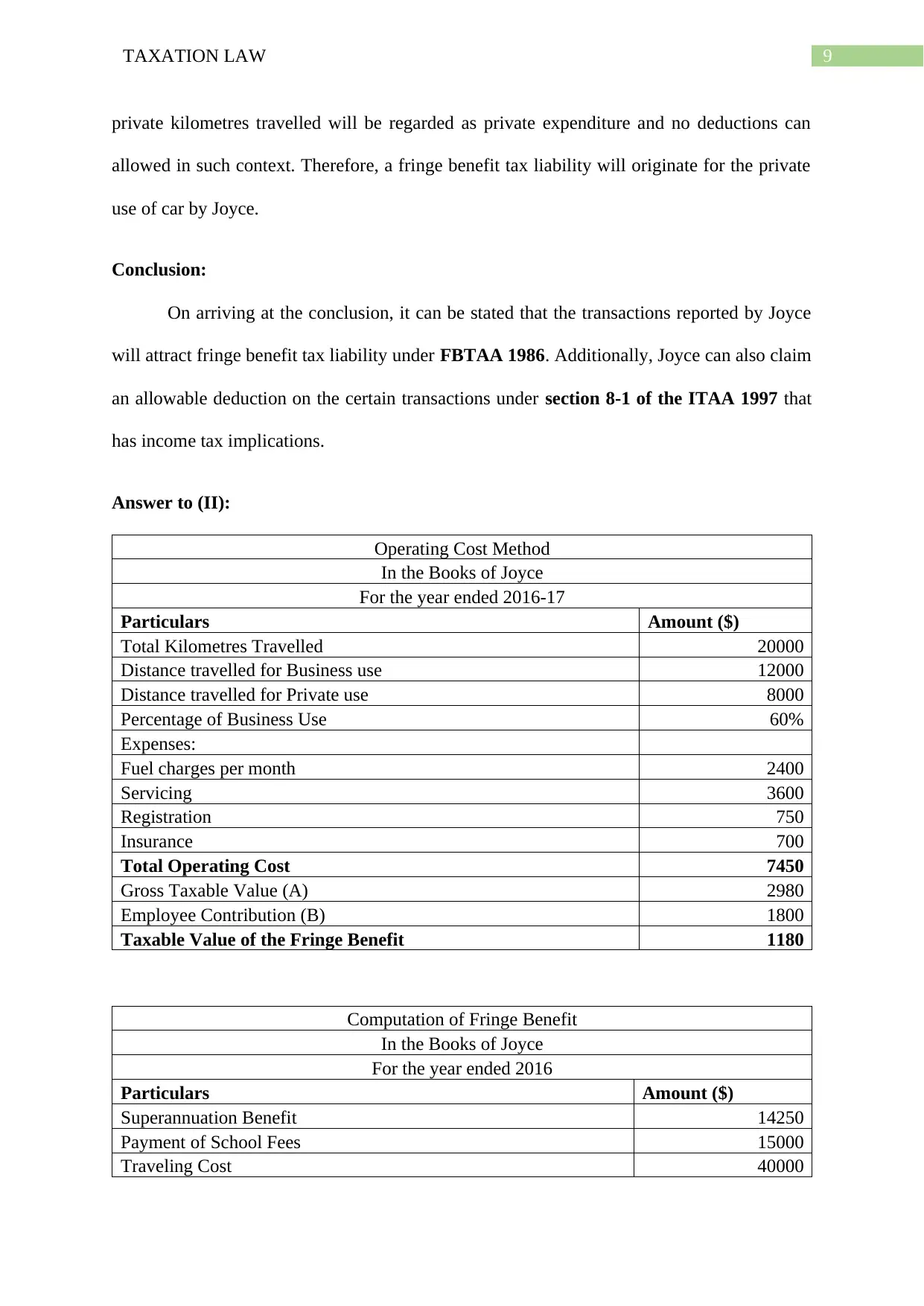
9TAXATION LAW
private kilometres travelled will be regarded as private expenditure and no deductions can
allowed in such context. Therefore, a fringe benefit tax liability will originate for the private
use of car by Joyce.
Conclusion:
On arriving at the conclusion, it can be stated that the transactions reported by Joyce
will attract fringe benefit tax liability under FBTAA 1986. Additionally, Joyce can also claim
an allowable deduction on the certain transactions under section 8-1 of the ITAA 1997 that
has income tax implications.
Answer to (II):
Operating Cost Method
In the Books of Joyce
For the year ended 2016-17
Particulars Amount ($)
Total Kilometres Travelled 20000
Distance travelled for Business use 12000
Distance travelled for Private use 8000
Percentage of Business Use 60%
Expenses:
Fuel charges per month 2400
Servicing 3600
Registration 750
Insurance 700
Total Operating Cost 7450
Gross Taxable Value (A) 2980
Employee Contribution (B) 1800
Taxable Value of the Fringe Benefit 1180
Computation of Fringe Benefit
In the Books of Joyce
For the year ended 2016
Particulars Amount ($)
Superannuation Benefit 14250
Payment of School Fees 15000
Traveling Cost 40000
private kilometres travelled will be regarded as private expenditure and no deductions can
allowed in such context. Therefore, a fringe benefit tax liability will originate for the private
use of car by Joyce.
Conclusion:
On arriving at the conclusion, it can be stated that the transactions reported by Joyce
will attract fringe benefit tax liability under FBTAA 1986. Additionally, Joyce can also claim
an allowable deduction on the certain transactions under section 8-1 of the ITAA 1997 that
has income tax implications.
Answer to (II):
Operating Cost Method
In the Books of Joyce
For the year ended 2016-17
Particulars Amount ($)
Total Kilometres Travelled 20000
Distance travelled for Business use 12000
Distance travelled for Private use 8000
Percentage of Business Use 60%
Expenses:
Fuel charges per month 2400
Servicing 3600
Registration 750
Insurance 700
Total Operating Cost 7450
Gross Taxable Value (A) 2980
Employee Contribution (B) 1800
Taxable Value of the Fringe Benefit 1180
Computation of Fringe Benefit
In the Books of Joyce
For the year ended 2016
Particulars Amount ($)
Superannuation Benefit 14250
Payment of School Fees 15000
Traveling Cost 40000
Paraphrase This Document
Need a fresh take? Get an instant paraphrase of this document with our AI Paraphraser
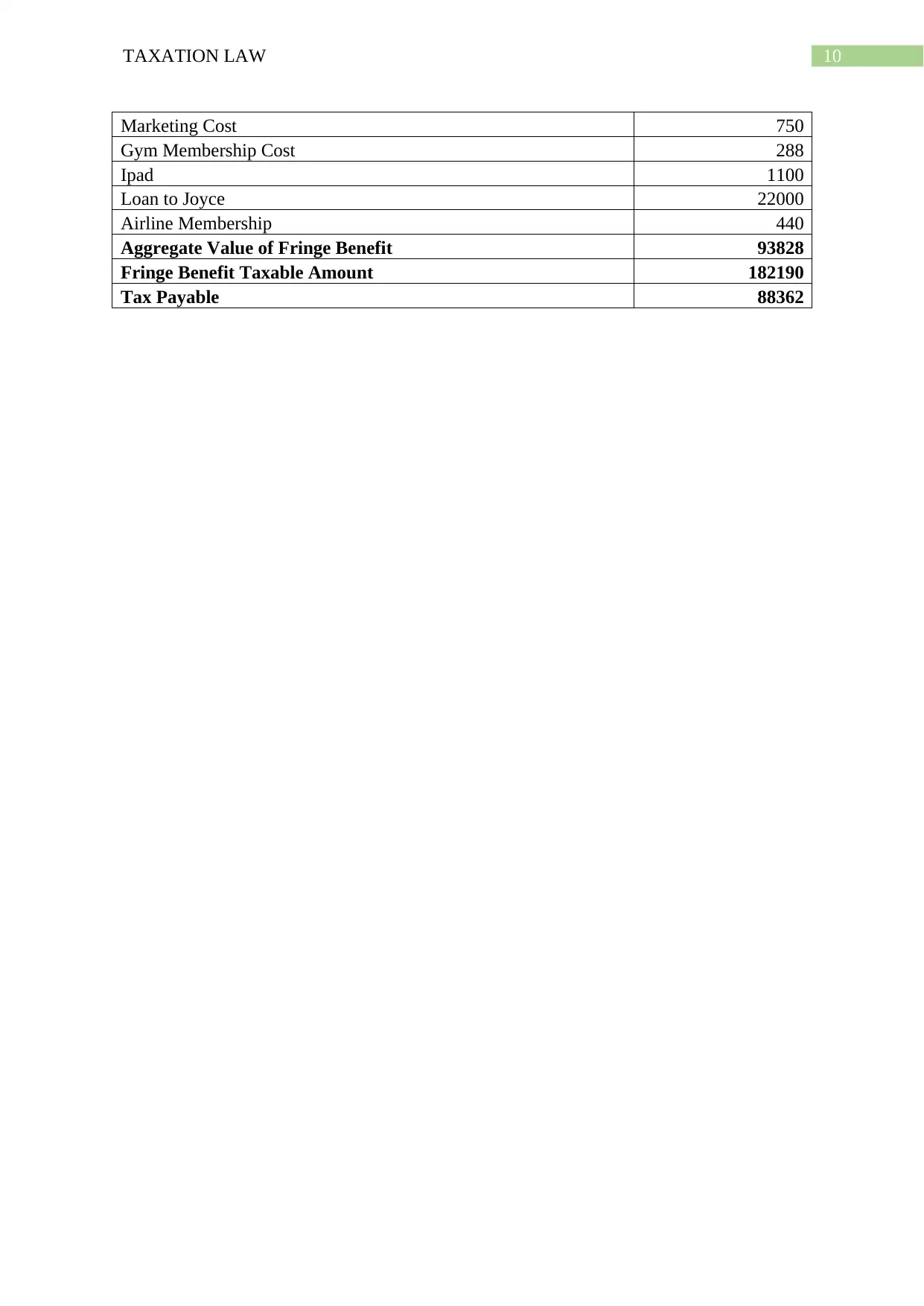
10TAXATION LAW
Marketing Cost 750
Gym Membership Cost 288
Ipad 1100
Loan to Joyce 22000
Airline Membership 440
Aggregate Value of Fringe Benefit 93828
Fringe Benefit Taxable Amount 182190
Tax Payable 88362
Marketing Cost 750
Gym Membership Cost 288
Ipad 1100
Loan to Joyce 22000
Airline Membership 440
Aggregate Value of Fringe Benefit 93828
Fringe Benefit Taxable Amount 182190
Tax Payable 88362
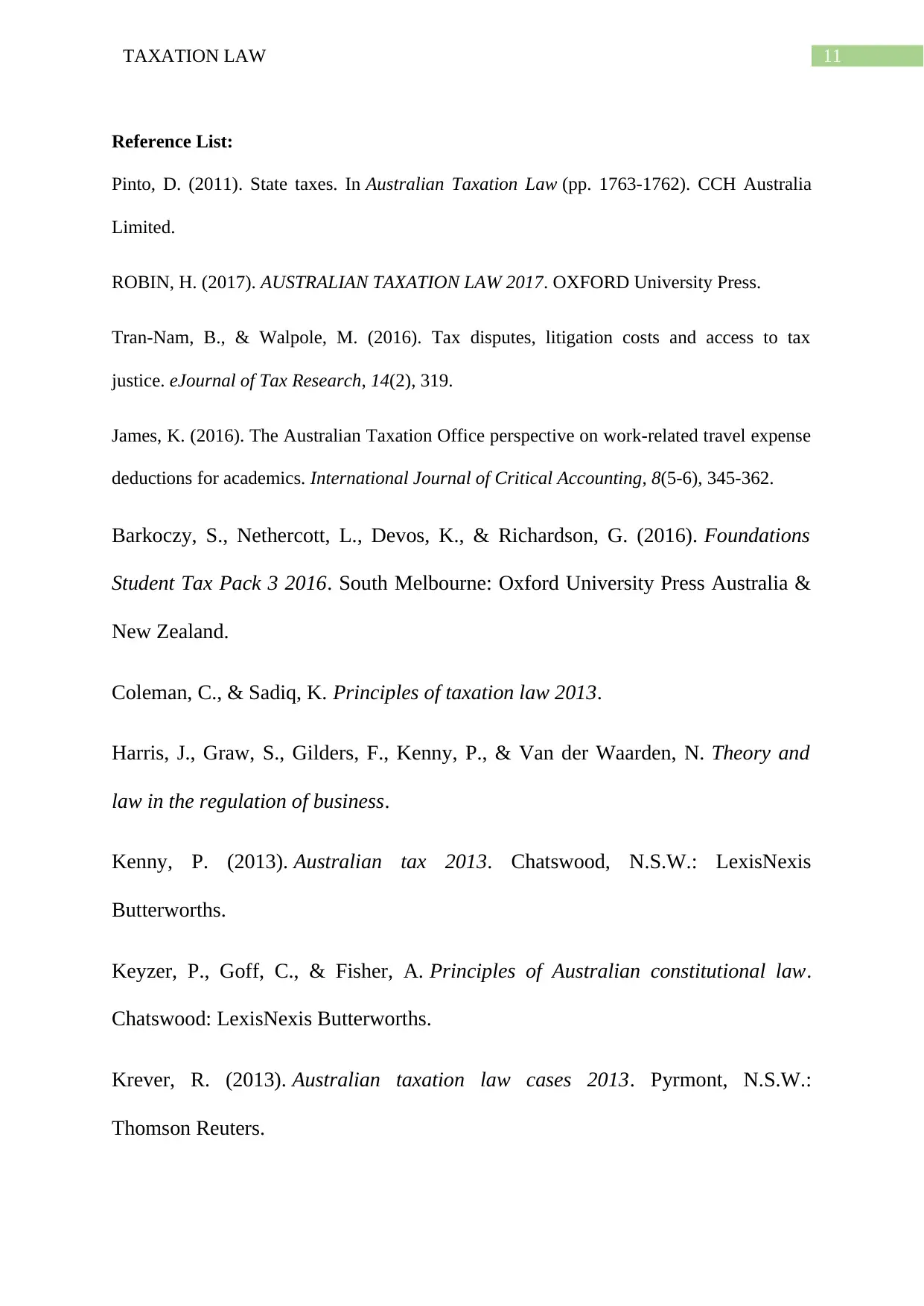
11TAXATION LAW
Reference List:
Pinto, D. (2011). State taxes. In Australian Taxation Law (pp. 1763-1762). CCH Australia
Limited.
ROBIN, H. (2017). AUSTRALIAN TAXATION LAW 2017. OXFORD University Press.
Tran-Nam, B., & Walpole, M. (2016). Tax disputes, litigation costs and access to tax
justice. eJournal of Tax Research, 14(2), 319.
James, K. (2016). The Australian Taxation Office perspective on work-related travel expense
deductions for academics. International Journal of Critical Accounting, 8(5-6), 345-362.
Barkoczy, S., Nethercott, L., Devos, K., & Richardson, G. (2016). Foundations
Student Tax Pack 3 2016. South Melbourne: Oxford University Press Australia &
New Zealand.
Coleman, C., & Sadiq, K. Principles of taxation law 2013.
Harris, J., Graw, S., Gilders, F., Kenny, P., & Van der Waarden, N. Theory and
law in the regulation of business.
Kenny, P. (2013). Australian tax 2013. Chatswood, N.S.W.: LexisNexis
Butterworths.
Keyzer, P., Goff, C., & Fisher, A. Principles of Australian constitutional law.
Chatswood: LexisNexis Butterworths.
Krever, R. (2013). Australian taxation law cases 2013. Pyrmont, N.S.W.:
Thomson Reuters.
Reference List:
Pinto, D. (2011). State taxes. In Australian Taxation Law (pp. 1763-1762). CCH Australia
Limited.
ROBIN, H. (2017). AUSTRALIAN TAXATION LAW 2017. OXFORD University Press.
Tran-Nam, B., & Walpole, M. (2016). Tax disputes, litigation costs and access to tax
justice. eJournal of Tax Research, 14(2), 319.
James, K. (2016). The Australian Taxation Office perspective on work-related travel expense
deductions for academics. International Journal of Critical Accounting, 8(5-6), 345-362.
Barkoczy, S., Nethercott, L., Devos, K., & Richardson, G. (2016). Foundations
Student Tax Pack 3 2016. South Melbourne: Oxford University Press Australia &
New Zealand.
Coleman, C., & Sadiq, K. Principles of taxation law 2013.
Harris, J., Graw, S., Gilders, F., Kenny, P., & Van der Waarden, N. Theory and
law in the regulation of business.
Kenny, P. (2013). Australian tax 2013. Chatswood, N.S.W.: LexisNexis
Butterworths.
Keyzer, P., Goff, C., & Fisher, A. Principles of Australian constitutional law.
Chatswood: LexisNexis Butterworths.
Krever, R. (2013). Australian taxation law cases 2013. Pyrmont, N.S.W.:
Thomson Reuters.
⊘ This is a preview!⊘
Do you want full access?
Subscribe today to unlock all pages.

Trusted by 1+ million students worldwide
1 out of 13
Related Documents
Your All-in-One AI-Powered Toolkit for Academic Success.
+13062052269
info@desklib.com
Available 24*7 on WhatsApp / Email
![[object Object]](/_next/static/media/star-bottom.7253800d.svg)
Unlock your academic potential
Copyright © 2020–2025 A2Z Services. All Rights Reserved. Developed and managed by ZUCOL.





